1. Introduction
 Core 2 is a ninth-generation x86 architecture microprocessor produced by Intel and it was officially released on July 27, 2006. Recently, Intel moved to the 45 nm manufacturing process and a new series of processors hit the market under the codenames " "Wolfdale (C2D)", "Yorkfield" (quad core) and "Yorkfield XE" (quad core extreme).
Core 2 is a ninth-generation x86 architecture microprocessor produced by Intel and it was officially released on July 27, 2006. Recently, Intel moved to the 45 nm manufacturing process and a new series of processors hit the market under the codenames " "Wolfdale (C2D)", "Yorkfield" (quad core) and "Yorkfield XE" (quad core extreme).
 Yorkfield is the codename for the Q9000 and QX9000 series of CPUs. It features a dual-die quad core design with two unified 6 MB L2 caches resulting in a total amount of 12 MiB L2-Cache. They also feature a 1333 MHz FSB and are compatible with the Bearlake chipset. The first two processors of this series were the Q9300 and Q9450 CPUs, released in late March 2008.
Yorkfield is the codename for the Q9000 and QX9000 series of CPUs. It features a dual-die quad core design with two unified 6 MB L2 caches resulting in a total amount of 12 MiB L2-Cache. They also feature a 1333 MHz FSB and are compatible with the Bearlake chipset. The first two processors of this series were the Q9300 and Q9450 CPUs, released in late March 2008.
Originally, Yorkfield CPUs were expected to be released in January 2008. However, the release was delayed to March 15th 2008. Initially this delay was attributed to an error found in the Yorkfield chip, but later reports claimed that the delay was necessary in order to ensure compatibility with the 4-layer print-circuit boards utilized by many mainstream motherboards.
An Intel quad-core processor consists of four complete execution cores in one physical processor , all running at the same frequency. All cores share the same packaging and the same interface with the chipset/memory. Imagine that a quad-core processor is like a eight-lane highway—it can handle up to twice as many cars as its four-lane predecessor without making each car drive four as fast. Similarly, with an Intel quad-core processor-based PC, people can perform multiple tasks such as downloading music and gaming simultaneously. Overall it offers a way of delivering more capabilities while balancing energy-efficient performance.
- Comparison
| |
Intel Core2 Quad Q9550
|
Intel Core2 Quad Q9450
|
Intel Core2 Quad Q9300
|
Intel Core2 Quad Q6600
|
| Processor Number |
Q9550 |
Q9450 |
Q9300 |
Q6600 |
| Architecture |
45 nanometer technology |
45 nanometer technology |
45 nanometer technology |
65 nanometer technology |
| L2 Cache |
12M |
12M |
6M |
8M |
| L3 Cache |
N/A |
N/A |
N/A |
N/A |
| Clock Speed |
2.83 GHz |
2.66 GHz |
2.50 GHz |
2.40 GHz |
| Front Side Bus Speed |
1333 MHz |
1333 MHz |
1333 MHz |
1066 MHz |
| Other Intel Technologies |
Intel 64,
Enhanced Intel SpeedStep Technology,
Quad-Core,
Intel VT,
Intel TXT |
Intel 64,
Enhanced Intel SpeedStep Technology,
Execute Disable Bit,
Intel VT,
Intel TXT |
Intel 64,
Enhanced Intel SpeedStep Technology,
Execute Disable Bit,
Intel VT,
Intel TXT |
Intel 64,
Intel VT,
Execute Disable Bit,
Enhanced Intel SpeedStep Technology,
Quad-Core |
| Package |
FC-LGA8 |
FC-LGA8 |
FC-LGA8 |
FC-LGA |
| Chipset |
G33 Express Chipset,
G35 Express chipset,
P35 Express chipset,
Q33 Express chipset,
Q35 Express chipset,
X38 Express chipset |
G33 Express Chipset,
G35 Express chipset,
P35 Express chipset,
Q33 Express chipset,
Q35 Express chipset,
X38 Express chipset |
G33 Express Chipset,
G35 Express chipset,
P35 Express chipset,
Q33 Express chipset,
Q35 Express chipset,
X38 Express chipset |
Intel 975X Express Chipset,
Intel P965 Express Chipset |
| Memory Type |
DDR2,
DDR3 |
DDR2,
DDR3 |
DDR2,
DDR3 |
NA |
| Boards |
NA |
NA |
NA |
Intel Desktop Board D975XBX2 |
| Slot/Socket Type |
LGA775 |
LGA775 |
LGA775 |
LGA775 |
| Pin Count |
775-land |
775-land |
775-land |
775-land |
| sSpec Number |
SLAN4 |
SLAN6 |
SLAMX |
SL9UM |
The above table illustrates the main differences between the 65nm and 45nm Quad Core processors. The new Q9xx processors work in combination with the P35 and X38 chipsets to properly work and offer an increased FSB of 1333MHz. The overall thermal dispass should be lower due to 45nm manufacturing process while the overclocking margins, as well as, the previous 65nm processors, are probably even better..
- Compatibility
The Yorkfield XE model QX9650 (45nm with 1333FSB) has currently a limited chipset compatibility, being compatible with just the X38, P35 and some high-performance 975X and P965 motherboards. BIOS updates are gradually being released to provide support for the new Penryn technology.
- Specifications
sSpec Number |
SLAWE |
CPU Speed |
2.50 GHz |
PCG: |
05A |
Bus Speed |
1333 MHz |
Bus/Core Ratio |
7.5 |
L2 Cache Size |
6 MB |
L2 Cache Speed |
2.5 GHz |
Package Type |
LGA775 |
Manufacturing Technology |
45 nm |
Core Stepping |
M1 |
CPUID String |
10677h |
Thermal Design Power |
95W |
Thermal Specification |
71.4°C |
VID Voltage Range |
0.85V – 1.3625V |
Box Order Code |
BX80580Q9300
BXC80580Q9300 |
OEM Order Code |
EU80580PJ0606M |
2. Retail package, installation
- Retail package
The Intel Core2Quad Q9300 costs around 235 Euro as found in several online stores around Europe.

The sticker placed on the top side of the package includes the basic information about the processor.

- Installation
There isn't much to say here. As always, just be careful when installing the CPU! After connecting all necessary power cables, you can power up your system. Everest Ultimate Edition 2007 provides enough information about the processor's abilities. The CPU multiplier is rather limited at 6x~7.5x and that may not allow the CPU to perform well under serious overclocking.

CPU-Z has even more information:

Note that the Core voltage is very low at the Auto mode, (1.2V). For our tests, the CPU was installed on an Asus Blitz Extreme mainboard using DDR3-1600 memory by SuperTalent .


3. Test Configuration
In order to test Intel C2Q9300 we used the Asus Blitz Extreme mainboard with the latest available BIOS (1007) installed and of course, DDR3 memory.
In this test graphs we have added the results of another Intel processor, the E6750, which not only offers higher absolute speeds but comes with 2MB less L2 cache memory. It's a typical scenario, where a C2D user wishes to "upgrade" its performance with a quad core processor. What can you really expect from such cpu change? We will find out with a variety of tests and benchmarks.
- CPU Cooler: Scythe Mugen
- Motherboard: Asus Blitz Extreme BIOS 1007 beta
- Memory: 2x1GB SuperTalent PC3-1600 CL7 (1333MHz @ 7-7-7-20-1T Divider 1:2, 1.90V)
- VGA: MSI 7600GT Silent with latest Nvidia drivers installed
- HDD: WD 80GB SATAI (primary)
- HDD: WD 80GB SATAI (secondary)
- Operating system: Windows XP SP2 with all latest updates installed
- Operating system: Windows VISTA 32bit SP1 with all latest updates installed
We also used a variety of benchmark software under both Windows XP and Vista operating systems.
- Office/Benchmarks (WinXP)
- Sisoft Sandra 2008 SP2
- Everest Lavasys Ultimated Edition 2007 v4.50
- SuperPI Mod v1.5XS
- wPrime v1.55 (stable)
- Cinebench vR10
- x264 Benchmark
- x264 HD Benchmark
- SysMark 2007 Preview
- TMPGEnc 4.0 Xpress
- Gaming/Benchmarks (VISTA 32bit)
- PC Mark Vantage v1.00 Nov Edition
- 3D Mark06 v1.2.0
- Crysis Retail v1.20
- Unreal Tournament 3 Demo
4. Benchmarks - Everest Ultimate Edition, SiSoftware Sandra
- Everest Ultimate Edition
 EVEREST Ultimate Edition is a leading system diagnostics and benchmarking solution for enthusiasts PC users, based on the EVEREST Technology. During system optimizations and tweaking it provides essential system and overclock information, advanced hardware monitoring and diagnostics capabilities to check the effects of the applied settings. CPU, FPU and memory benchmarks are available to measure the actual system performance and compare it to previous states or other systems. Furthermore, complete software, operating system and security information makes EVEREST Ultimate Edition a comprehensive system diagnostics tool that offers a total of 100 pages of information about your PC. The software has build-in several tests for memory and CPU/FPU.
EVEREST Ultimate Edition is a leading system diagnostics and benchmarking solution for enthusiasts PC users, based on the EVEREST Technology. During system optimizations and tweaking it provides essential system and overclock information, advanced hardware monitoring and diagnostics capabilities to check the effects of the applied settings. CPU, FPU and memory benchmarks are available to measure the actual system performance and compare it to previous states or other systems. Furthermore, complete software, operating system and security information makes EVEREST Ultimate Edition a comprehensive system diagnostics tool that offers a total of 100 pages of information about your PC. The software has build-in several tests for memory and CPU/FPU.
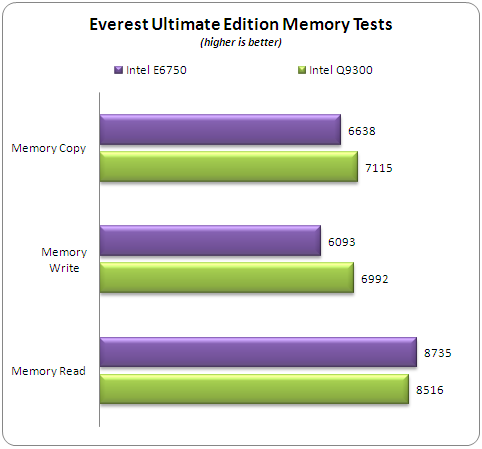
Memory performance was higher for Q9300, compared to the E6750.
In the CPU tests, the differences are higher, as it was expected:
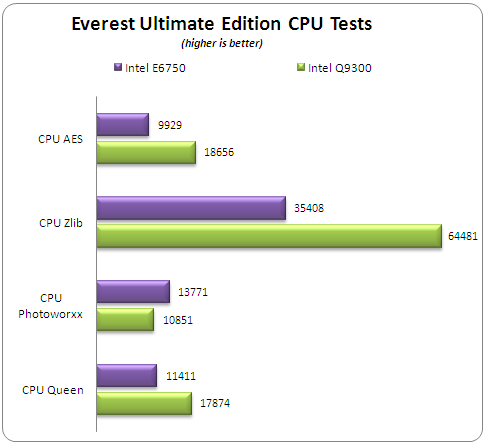

Summing up all above results we can say that Intel Q9300 was faster is almost all Everest Ultimate Edition test we have tried. Let's move on to the Sisoft Sandra benchmarking software.
 SiSoftware Sandra (the System ANalyser, Diagnostic and Reporting Assistant) is an information & diagnostic utility. It should provide most of the information (including undocumented) you need to know about your hardware, software and other devices whether hardware or software. It works along the lines of other Windows utilities, however it tries to go beyond them and show you more of what's really going on. Giving the user the ability to draw comparisons at both a high and low-level. You can get information about the CPU, chipset, video adapter, ports, printers, sound card, memory, network, Windows internals, AGP, PCI, PCIe, ODBC Connections, USB2, 1394/Firewire, etc. Sisoft Sandra offers a variety of tests for Memory and CPU.
SiSoftware Sandra (the System ANalyser, Diagnostic and Reporting Assistant) is an information & diagnostic utility. It should provide most of the information (including undocumented) you need to know about your hardware, software and other devices whether hardware or software. It works along the lines of other Windows utilities, however it tries to go beyond them and show you more of what's really going on. Giving the user the ability to draw comparisons at both a high and low-level. You can get information about the CPU, chipset, video adapter, ports, printers, sound card, memory, network, Windows internals, AGP, PCI, PCIe, ODBC Connections, USB2, 1394/Firewire, etc. Sisoft Sandra offers a variety of tests for Memory and CPU.
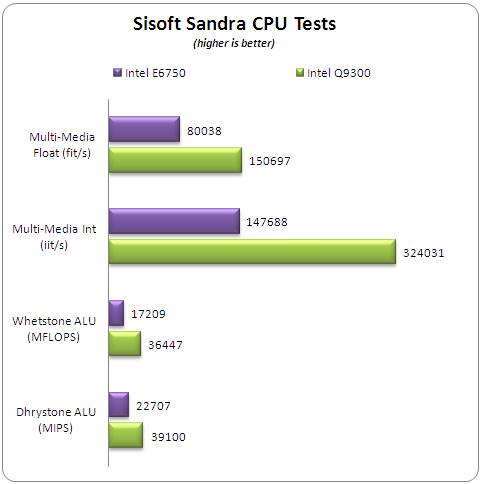


The Sisoft Sandra CPU/FPU/Memory tests confirm our original findings with the Everest Ultimate Edition, since both software take advantage of the multi-core architecture of the newest processors. The results are clearly in favor of the quad processor.
5. Benchmarks - PCMark Vantage, SYSmark 2007 Preview
 PCMark Vantage is the first objective hardware performance benchmark for PCs running 32 and 64 bit versions of Microsoft Windows Vista. PCMark Vantage is suited for benchmarking any type of Microsoft Windows Vista PC from multimedia home entertainment systems and laptops to dedicated workstations and hi-end gaming rigs. The software shows the user where their system soars or falls flat, and how to get the most performance possible out of their hardware.
PCMark Vantage is the first objective hardware performance benchmark for PCs running 32 and 64 bit versions of Microsoft Windows Vista. PCMark Vantage is suited for benchmarking any type of Microsoft Windows Vista PC from multimedia home entertainment systems and laptops to dedicated workstations and hi-end gaming rigs. The software shows the user where their system soars or falls flat, and how to get the most performance possible out of their hardware.
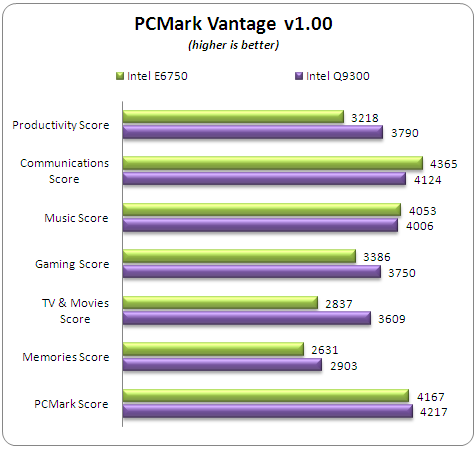
The Intel Q9300 is faster in most sub-tests, staying behind just in the Communications and Music scores. However, the overall performance (score) is not that big as you might have been expecting.
 BAPCo's SYSmark 2007 Preview is an application-based benchmark that reflects
usage patterns of business users in the areas of Video creation,
E-learning, 3D Modeling and Office Productivity.
BAPCo's SYSmark 2007 Preview is an application-based benchmark that reflects
usage patterns of business users in the areas of Video creation,
E-learning, 3D Modeling and Office Productivity.
The benchmark
utilities utilize real life applications like: Adobe After
Effects 7, Adobe Illustrator CS2, Adobe Photoshop CS2, AutoDesk 3ds Max
8, Macromedia Flash 8, Microsoft Excel 2003, Microsoft Outlook 2003,
Microsoft PowerPoint 2003, Microsoft Word 2003, Microsoft Project 2003,
Microsoft Windows Media™ Encoder 9 series, Sony Vegas 7, SketchUp 5 and
WinZip 10.0.
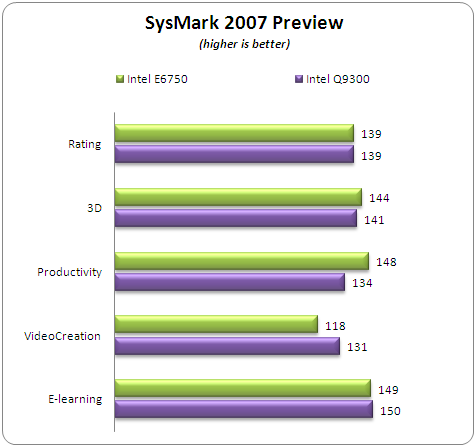
Despite the fact that the subtest results were different, the overall rating is exactly the same for both processors. Looking at the sub tests, we can see a clear victory for the Q9300 CPU at the VideoCreation test, while it stays behind in the 3D/Productivity tests (probably due to the slight faster MHz speed of E6750). In the E-learning test, both processors are gave the same score.
6. Benchmarks - MAXON CINEBENCH, x264 HD Benchmark, TMPGEnc 4 Xpress
 MAXON CINEBENCH is based on MAXON's award-winning animation software, CINEMA 4D, which
is used by studios and production houses worldwide for 3D
content creation.
MAXON CINEBENCH is based on MAXON's award-winning animation software, CINEMA 4D, which
is used by studios and production houses worldwide for 3D
content creation.
MAXON CINEBENCH runs several tests on your computer to measure the
performance of the main processor and the graphics card under real
world circumstances. The benchmark application makes use of up to 16
CPUs or CPU cores and is available for Windows (32-bit and 64-Bit) and
Macintosh (PPC and Intel-based). The resulting values among different
operating systems are 100% comparable and therefore very useful with
regard to purchasing decision-making.

The CineBench R10 benchmark uses all four cores of Intel Q9300 and therefor, it can render the test image almost two times faster. When it uses a single core, both cpus seems to perform the same.
- x264 HD Benchmark
x264 Benchmark utilizes the next generation of Video Encoding benchmarks with support
for x264 codec that is considered to be one of the most demanding for
Video applications. Simply put, it is a reproducible measure of fast your machine can encode a short, HD video clip to a high quality x264 video file. It's nice because everyone running it will use the identical video clip and software. The video encoder (x264.exe) reports a fairly accurate internal benchmark (frames per second) for each pass of the video encode and it also uses multi-core processors very efficiently. All these factors make this an ideal benchmark to compare different processors and systems to each other.
The benchmark procedure is very simple, you just run a batch file
that encodes the same file four times. The software provides two results, one for each pass of encoding. The average performance of this test is available in the charts below.

The x264 HD benchmark uses the 100% of the cpu. As a result, the the Intel Q9300 is almost two times faster than the E6750.
- TMPGEnc 4 Xpress
With MPEGEncoder, the overall encoding time will be reduced as CPU speed gets faster. TMPGEnc converts *.AVI files to MPEG1, the format which is used in VideoCDs. Using a variety of options in TMPGEnc, you can compress your video file in high quality. TMPGEnc enables you to adjust bitrate, quantize matrix, GOP structure, interlacing and many other parameters so that you can create the most appropriate movie file depending on your needs.
For our test we use an AVI file around 350MB encoded with the Xvid (Mpeg4 ASP) codec. We use the build-in Mpeg4 ASP/AVC MediaEncoder profile and by dividing the amount of total frames via the encoding time, we get the average frame/sec speed of each processor.

With TMPGEnc 4 Xpress we can see some interesting results. With ASP encoding, the performance difference is not that big, since ASP encoding doesn't quite use all four cores of the Q9300 processor. However when we selected the AVC profile, we got a significant performance boost from the Intel Q9300, big enough to justify its high retail price.
7. Benchmarks - SuperPI, wPrime
SuperPI has become a utility for benchmarking modern systems. In August 1995, the calculation of pi up to 4,294,960,000 decimal digits was succeeded by using a supercomputer and SuperPI, in the University of Tokyo. The program was written by D.Takahashi and he collaborated with Dr. Y.Kanada at the computer center, the University of Tokyo.

The software offers up to 32M calculations of PI numbers. We set 8M calculations for testing both CPUs:


The Intel Q9300 proved to be overall faster than E6750 finishing first the 32M calculation test. In the 1M calculation test, the Intel E6750 was faster, due to its faster clock speed.
- wPrime
wPrime is a benchmarking application designed to use a highly multithreaded approach to calculating the square-roots of large amounts of numbers (up to 32 billion at this stage!)

wPrime uses all four cores of quad processors, therefore it can finish the task much faster than a C2D.
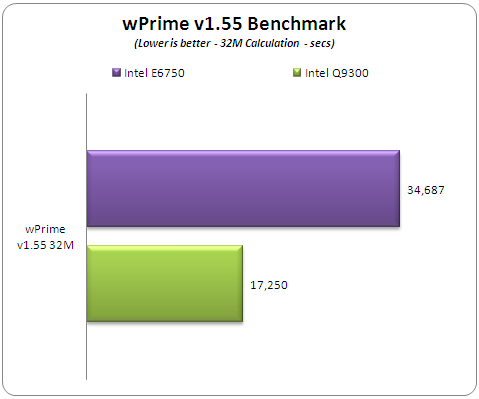
The Intel Q9300 almost took half the time to finish this test...
8. Benchmarks - 3DMark06
 3DMark®06 is the worldwide standard in advanced 3D game performance benchmarking. The software uses advanced real-time 3D game workloads to measure PC performance using a suite of DirectX 9 3D graphics tests, CPU tests, and 3D feature tests. 3DMark06 tests include all new HDR/SM3.0 graphics tests, SM2.0 graphics tests, AI and physics driven single and multiple cores or processor CPU tests and a collection of comprehensive feature tests to measure gaming performance.
3DMark®06 is the worldwide standard in advanced 3D game performance benchmarking. The software uses advanced real-time 3D game workloads to measure PC performance using a suite of DirectX 9 3D graphics tests, CPU tests, and 3D feature tests. 3DMark06 tests include all new HDR/SM3.0 graphics tests, SM2.0 graphics tests, AI and physics driven single and multiple cores or processor CPU tests and a collection of comprehensive feature tests to measure gaming performance.

If we believe what 3DMark 06 says, the Intel Q9300 should be faster in games, even by a small margin, compared to the Intel E6750. Is that true? Let's find out by running some other gaming results using Crysis (1024x768) CPU benchmark and Unreal Tournament 3 Demo.
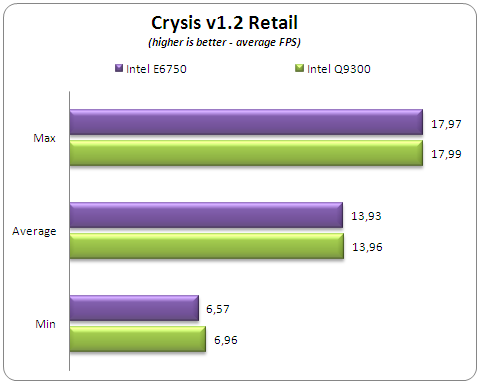
In the Crysis benchmark ,the two processors performed almost equally. There is not any difference that a user could practically experience, either in the min/max/average results.

With Unreal Tournament 3 demo, we saw some small performance gain, in favor of the Intel Q9300.
9. Benchmarks - Overclocking
Overclocking the Intel C2D/Quad processor is something that most of us will give it try, in order to further boost overall performance of our system. All currently sold Intel C2D processors are very good overclockers, allowing you to easily get much higher clocks. With the newest 45nm Intel C2Quad processors, things should be very easy as well or not?
Things are not that bright, at least with the Intel Q9300, since its x7.5 internal multiplier affects the overall process. So let's make some calculations. In order to reach the 3.50GHz we have to rise up the FSB at 470MHz! Heat shouldn't be such a big issue with 45nm processors, but going from 3.50GHz towards 4.0GHz could be nearly impossible, since FSB would have to climb up to 533MHz! Not many motherboards on the market support this this would require additional cooling improvements to the north/southbridge chipsets.
After several attempts to achieve stability we are ready to proceeded to the tests/benchmarks under both WinXP and VISTA. Our fully stable system reached the 3.525GHz, by keeping internal multiplier at x7.5 and using a 470MHz FSB frequency.

Temperatures at idle mode are good, considering that we have a quad-core CPU here. Of course the cpu cooler we used in this test played its role here

Someone might ask why we couldn't get things stable at higher speeds. Overclocking Quad Core processors is not that easy, compared to the C2Ds. In fact, we had to make several manual adjustments in order to stabilize things and of course we used additional cooling for NB chipsets. We assume that under typical cooling configurations, overclocking should be lower than 3.4GHz. Remember that the cpu natively runs at 2.50GHz, so a 0.9~1GHz overclocking boost should not be considered as low.
The following BIOS settings offered stability in the Asus Blitz Extreme system
- CPU Ratio Setting: x7.5
- FSB: 470
- PCI-E: 100
- DRAM Frequency/Command Rate/Timings/Voltage (depends on your memory)
- CPU Core: 1.400V
- CPU GTL Voltage Reference: Auto
- Loadline Calibration: Auto
- FSB Termination: 1.60V
- NB Voltage: 1.65V
- SB Voltage: Auto
- PLL Voltage: 2.00V
Using other motherboards or even higher voltages may offer even higher speeds, but we feel that most users will be able to reach the 3.3~3.4GHz without much effort. For us it's interesting to see the performance gain of the the Intel Q9300 running at 3.52GHz, compared with a Intel E6750@3.72GHz.
Benchmark |
Intel Q9300@3.52GHz |
Intel E6750@3.72GHz |
%Difference |
x264 HD Benchmark |
43.51 |
26.59 |
+63.63% |
SuperPI |
4.08969 |
4.10359 |
+0.34% |
SysMark 2007 Preview |
170 |
171 |
-0.58% |
CineBench R10 |
15307 |
11081 |
+38.14% |
TMPGEnc 4 Xpress |
246.03 |
201.05 |
+22.73% |
wPrime |
13.656 |
25.016 |
+45.41% |
PCMark Vantage |
4910 |
4832 |
+1.61% |
3DMark 06 |
3527 |
3459 |
+1.97% |
Crysis |
14.16 |
14.03 |
+0.92% |
Unreal Tournament 3 |
32.37 |
33.32 |
-2.85% |
The results are at least interesting. There is a good performance gain when the application uses all the four cores of the Intel Q9300, like the x264 HD Benchmark, CineBench R10, TMPGEnc 4 and wPrime. In other cases, the performance difference is just 1.97~0.34%. The Intel E6750 was actually faster by a 2.85% in two cases.
10. Final words
 The recent release of the Intel Yorkfield processor provides a new "budget" solution for quad core lovers. Apart from the difference in the retail price, the two available Intel Q9300 and the Q9450 models offer different capabilities.
The recent release of the Intel Yorkfield processor provides a new "budget" solution for quad core lovers. Apart from the difference in the retail price, the two available Intel Q9300 and the Q9450 models offer different capabilities.
Intel's migration from the 65nm to the 45nm manufacturing process gave us hopes that this baby would overclock like crazy, especially since the Q6600 had been proved a very overclockable model. The truth is that the Intel Q9300 can be overclocked up to 3.3~3.4GHz without much effort, when combined with a motherboard, that can set voltages etc.. Pushing the CPU above the 3.4GHz requires many tests and probably additional cooling for NorthBridge to keep the system cool and stable.

When compared with a C2D, in our case Intel E6750, the Intel Q9300 is the faster especially when the application/game is designed to take advantage of all four available cores. We assume that in video and audio encoding tasks, the Q9300 will be proved a very good solution for you considering its "low" retail price (~235 Euro).
Normal/desktop users and especially gamers will not benefit from buying the Intel Q9300, either in terms of performance and overclocking. In this case, we assume that you could spend some additional euros in order to have the overclocking champions Intel E8400 and E8500 CPUs that can reach up to 4.2GHz speeds!
To sum up, the Intel Q9300 is an interesting processor for users that can't do without a quad core. Many users may disagree or even prefer the Intel Q6600 that costs 15 euros less and offer more overclocking margins. Others may save 90-100 Euros and buy the Intel E8400 that will be faster in absolute terms of gaming/desktop use. As always, the final choice is yours.